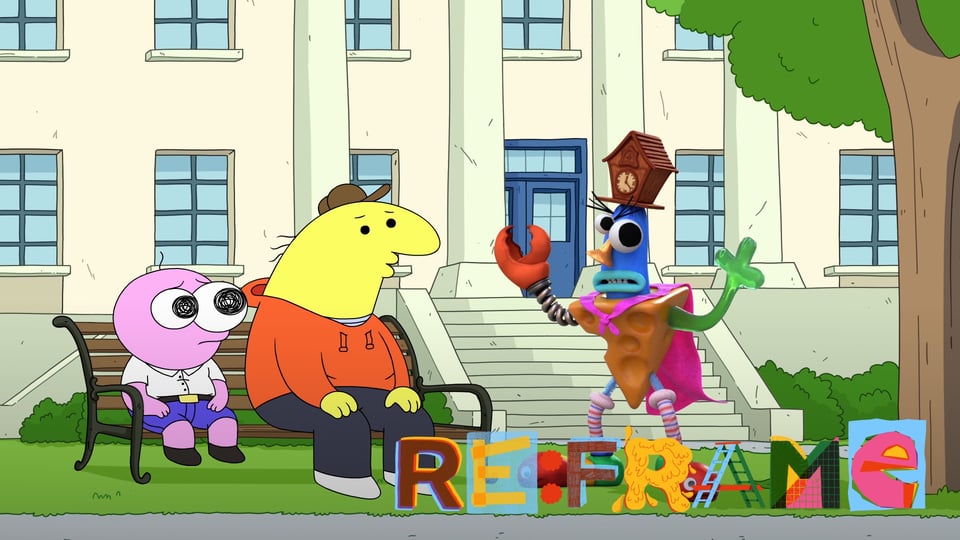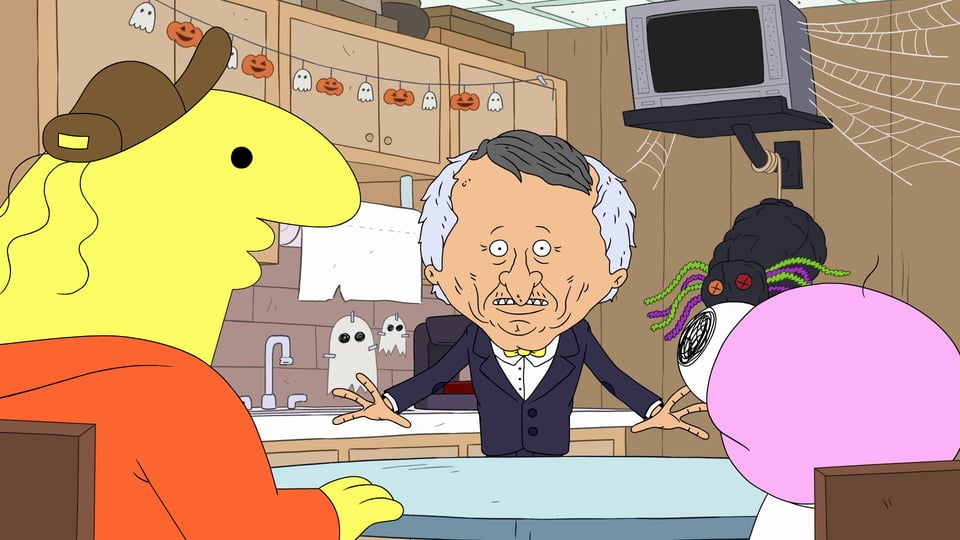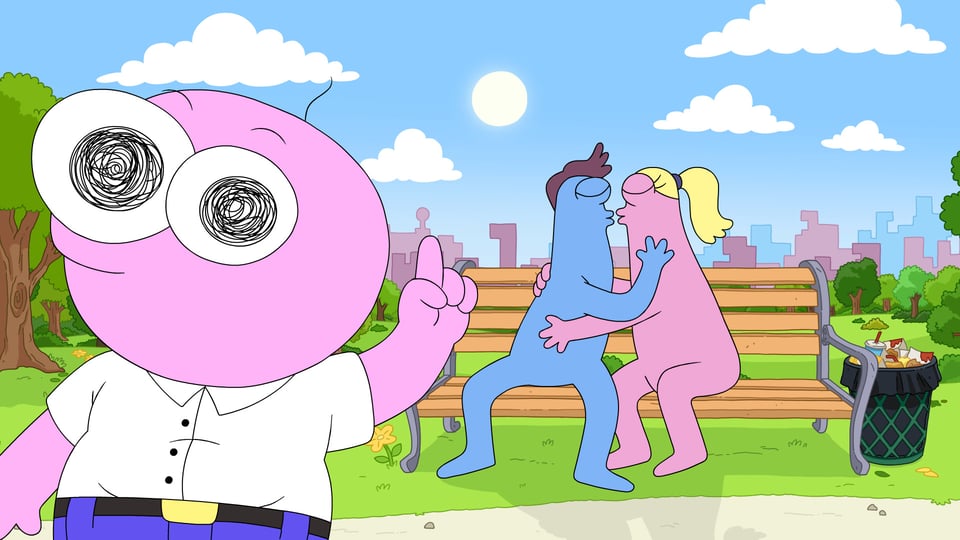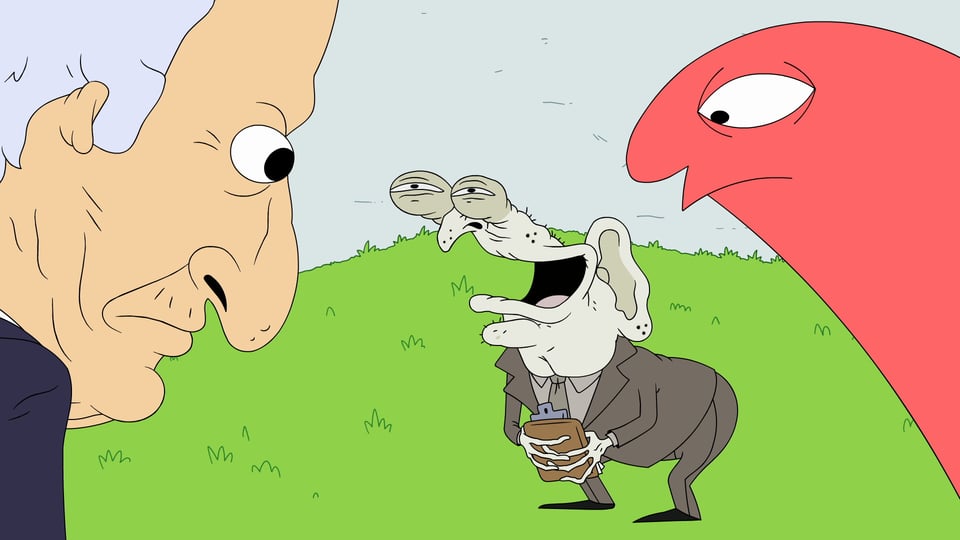The frog stays in the picture
Looking at Smiling Friends through its soon-to-be "highly acclaimed award-winning fan-favourite" episode.
by Kambole Campbell

A tongue-in-cheek reference in The Simpsons characterized Smiling Friends as pure chaos, a cacophony of noise and unsettling imagery that makes Marge recoil in horror as Bart shows it to her on his tablet, praising the jokes and the storytelling.
"They've got a good point (…), they nailed us," Zach Hadel, co-creator of Smiling Friends, said at a panel at Annecy a month later, clearly thrilled by the nod ("just any reference from them is so cool"). He added, "We're angry, expect a response! It's gonna be nasty for The Simpsons, watch out Homer." While the three episodes I've seen of the new season are yet to skewer the Simpsons patriarch, that moment of self-reflection on stage runs parallel with these new installments (I won't say it's a direct line, as the production timeline likely doesn't line up; the first episode was finished just in time to show at Annecy).

But still, the question of what Smiling Friends even is plays into a lot of the humor in two out of three of these first episodes, produced as ever by Studio Yotta and Princess Bento Studios (with animation services from Saerom Production). The standout to viewers will likely be episode two, titled "Le Voyage Incroyable de Monsieur Grenouille," boasting the return of the fan-favorite amphibian psychopath, Mr. Frog. The ironic tone of the French title is a little heads up of what might be the best gag of the episode: that the most violent character gets the episode with the most visually polished (in the traditional sense) of the entire series.
The creative team credited is the same as with any other episode, with episode director David Hootselle as well as storyboard artist Hannah Daigle, background supervisor Greg Bartlett, with credit for "specialty animation, compositing and VFX" going to Hadel, co-creator Michael Cusack, and producing partner Aron Fromm's recently announced Zam Studios (who also handles the live-action photography of people composited into the show, with direction from Fromm). The difference in direction is striking enough and committed to that one style that it wouldn't have been a huge surprise if they'd flown a guest in, but they hadn't.

None of this is to say that Smiling Friends has never had technical chops, just different visual priorities. For one, this is the same team as usual, and the series on a whole often runs the gamut of animation mediums (and live action!), which makes these episodes feel holistic somehow. Such as in the episode prior and even in pockets of this one – it usually goes for mixed-media crudeness. So of course, the show's most violent psychopath (and canonical guest on both Jimmy Fallon and the Joe Rogan podcast) gets the handsomely drawn episode about self-discovery, one mostly committed to that one look. In that same making-of presentation at Annecy, Hadel, Cusack, and Fromm spoke about the fluidity of the show's production, but also about how Season 3 led to them using, "a lot of styles in animation we didn't get to do." It's amusing that in the first episode this means a 3D-animated character with a cuckoo clock for a hat played by Conner O'Malley, while in the second episode, this means lush and layered lighting and detailed forestry rather than starkly lit urban hell.
After accomplishing everything there is to accomplish (the details I will not spoil for now), Mr. Frog sinks into existential despair after realizing he has nothing left to do. Pim (Cusack) and Charlie (Hadel) stumble across him, and Charlie's whimsical (and charmingly bad) song about life's simple pleasures provokes Mr. Frog into a journey back to his roots. The backgrounds of Smiling Friends are typically desolate and disturbing, or at the very least sparingly presented: by contrast, Mr. Frog's personal odyssey, with its detailed background art and somber tone in the episode's back half, takes on the appearance of a fairy tale produced by a European studio. (The episode title and description winks at this, calling it the "highly acclaimed award-winning fan favorite").

This carries into the season's third episode, "Mole Man," which on one hand returns to the visual palette and median tone of typical Smiling Friends episodes, but is amusingly self-reflective about what exactly that means, as a new character familiar with Pim and Charlie creepily espouses his love of their "realistic dialogue" and how they deal with random things bursting into the room screaming before turning into sand (which has since quickly become a popular meme). I suppose The Simpsons did, in good spirits, nail them to the wall in that regard. But what's fun about the new season so far is how much Hadel, Cusack, and Fromm have already thought about why, and how they can make that in itself funny.
/out of frame
⚔️ Kambole: Ranma ½ is back! I love the manga and have appreciated this pastel-coloured take on it. In other mediums, I've been obsessively playing Hades 2 (not to brag, but I've just hit credits and beaten all Vow of Rivals bosses) – appreciative of the game's graphic stylings as well as its general mechanical brilliance. For more on the former, Tous wrote a great feature on the animated trailer (and, not to toot my own horn too much again, so did I)!
💰 Rollin: I'm not as far along in Hades 2 as my compatriots, but what a game. And animation! Maybe I'll catch up this weekend…
🛠️ Toussaint: I've been slowly making my through Silent Hill f in my spare time. So far, I love the moment-to-moment experience of trudging through the fog-laden horrors of Ebisugaoka, stalked by fleshy mannequin-like monstrosities while Shimizu Hinako embarks on a journey of spiritual self-discovery. I also love ronununu’s now-viral animated gif of Hinako dodging an oncoming attack from a creature before beating the shit out of them. Don’t flinch!